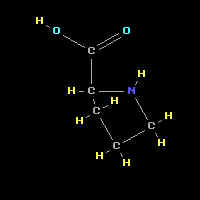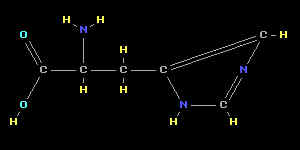December 24, 2006 - "The End of It"
Dickens put those four words together as the title of the concluding Stave of his "Christmas Carol". And you may indeed wonder how, after the marathon technical textbook of the last 21 days how I might also make "The End of It". But God has also provided, yes, even for this, just as He provides us with the sunrise and sunset...
As we have gone through our 20 meditations pondering the 20 mysteries of the Rosary as well as the 20 amino acids denoted by the triples of mRNA, I have mentioned the "codes" by which each amino acid is indicated. This was the stupendous discovery made by Watson and Crick in the 1950s: the sequence of bases (the letters A, C, G, U) in the mRNA - the "working blueprint" used in building a protein - is "scanned" in triples, and each triple stands for exactly one amino acid. And, since there are four possible bases, and three positions for each base, there must be a total of sixty-four possible codes: ranging from AAA (which stands for Lysine) through CCC for Proline and GGG for Glycine, to UUU for Phenylalanine. The code AUG stands for Methionine, but it is also the special start code which begins the translation from RNA into protein.
Now, if you have been watching very carefully, you may have put all these 20 days of data together into a table, and listed all the names of the twenty...
The amino acids
| J2 | A | Ala | Alanine |
| L2 | R | Arg | Arginine |
| S5 | N | Asn | Asparagine |
| S2 | D | Asp | Aspartic acid |
| S1 | C | Cys | Cysteine |
| S3 | E | Glu | Glutamic acid |
| S4 | Q | Gln | Glutamine |
| L3 | G | Gly | Glycine |
| G3 | H | His | Histidine |
| J5 | I | Ile | Isoleucine |
| J4 | L | Leu | Leucine |
| L5 | K | Lys | Lysine |
| J1 | M | Met | Methionine |
| G1 | F | Phe | Phenylalanine |
| G5 | P | Pro | Proline |
| L1 | S | Ser | Serine |
| L4 | T | Thr | Threonine |
| G4 | W | Trp | Tryptophan |
| G2 | Y | Tyr | Tyrosine |
| J3 | V | Val | Valine |
Or, perhaps you will have collected the various codes together using the traditional alphabetical arrangement:
The Genetic Code
| A A A | Lysine | C A A | Glutamine | G A A | Glutamic acid | U A A | ? |
| A A C | Asparagine | C A C | Histidine | G A C | Aspartic acid | U A C | Tyrosine |
| A A G | Lysine | C A G | Glutamine | G A G | Glutamic acid | U A G | ? |
| A A U | Asparagine | C A U | Histidine | G A U | Aspartic acid | U A U | Tyrosine |
| A C A | Threonine | C C A | Proline | G C A | Alanine | U C A | Serine |
| A C C | Threonine | C C C | Proline | G C C | Alanine | U C C | Serine |
| A C G | Threonine | C C G | Proline | G C G | Alanine | U C G | Serine |
| A C U | Threonine | C C U | Proline | G C U | Alanine | U C U | Serine |
| A G A | Arginine | C G A | Arginine | G G A | Glycine | U G A | ? |
| A G C | Serine | C G C | Arginine | G G C | Glycine | U G C | Cysteine |
| A G G | Arginine | C G G | Arginine | G G G | Glycine | U G G | Tryptophan |
| A G U | Serine | C G U | Arginine | G G U | Glycine | U G U | Cysteine |
| A U A | Isoleucine | C U A | Leucine | G U A | Valine | U U A | Leucine |
| A U C | Isoleucine | C U C | Leucine | G U C | Valine | U U C | Phenylalanine |
| A U G | Methionine | C U G | Leucine | G U G | Valine | U U G | Leucine |
| A U U | Isoleucine | C U U | Leucine | G U U | Valine | U U U | Phenylalanine |
And you will have discovered that there are three codes which haven't been mentioned. Ah, yes. Here we have an interesting lesson.
Remember the movie "Fantasia" where a young mouse is seen as an apprentice to a wizard? He is told to fetch water (no, it wasn't for a wedding feast this time!) and being a bit lazy, he thought he could get away with invoking his master's magic to assist him by commanding the broom to act as his servant... except that he does not know the word by which he can command the broom to STOP.
In one of the special topics of computing, we call this the "terminating condition": the way in which we "finish" or "complete" a certain kind of task. Astronomers (when they remember, or feel the need to be pedantic) do not say the words "sunrise" or "sunset" but speak of the "morning terminator" or "evening terminator" which mark the bounds of the day and the night...
Yes, this delimiting extends even to the depths of biology. We have already seen that AUG (besides standing for Methionine) marks the start point of translation. The three codes which were not yet mentioned, marked in the above table with a "?", are UAA, UAG, and UGA - the "terminators" of translation. They mark the place where the completed protein is detached from the ribosome (the protein-buiilding machine). It is now free to go about its business, to be useful for the work of the living cell.
In our analogy, we recall that the Rosary also has a special concluding prayer, the "Hail Holy Queen" with its "collect" (from the feast of the Holy Rosary, October 7). This prayer "completes" the larger prayer, and "frees" - not the prayer, but us - to go about our business, and be useful in the life of the Mystical Body.
Let us pray:
O God Who by the life, death, and resurrection of Your only-begotten Son has purchased for us the rewards of eternal life, grant we beseech You, that by meditating upon these mysteries of the Most Holy Rosary of the Blessed Virgin Mary, we may imitate what they contain and obtain what they promise. Through Christ our Lord. Amen.




















